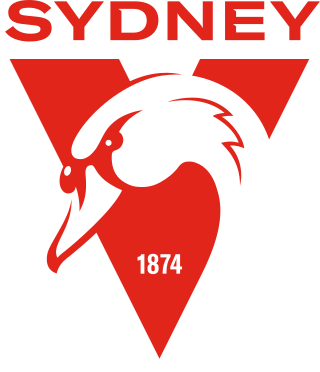
The Sydney Swans are a professional Australian rules football club based in Sydney, New South Wales. The men's team competes in the Australian Football League (AFL), and the women's team in the AFL Women's (AFLW). The Swans also field a reserves men's team in the Victorian Football League (VFL).
Anthony Howard Lockett is a former Australian rules footballer who played for the St Kilda Football Club and Sydney Swans in the Australian Football League (AFL). Nicknamed "Plugger", he is considered one of the greatest full forwards and players in the game's history.

Simon Madden is a former Australian rules footballer who played his entire 19-season career with the Essendon Football Club from 1974 until 1992. Madden is one of the most decorated players in the club's history and widely regarded as one of the finest ruckmen to ever play the game.
The 2002 AFL season was the 106th season of the Australian Football League (AFL), the highest level senior Australian rules football competition in Australia, which was known as the Victorian Football League until 1989. The season featured sixteen clubs, ran from 28 March until 28 September, and comprised a 22-game home-and-away season followed by a finals series featuring the top eight clubs.

Barry Andrew Hall is a former professional Australian rules footballer who played for the St Kilda Football Club, Sydney Swans and Western Bulldogs in the Australian Football League (AFL). He is considered to be one of the best forwards of the modern era, being named All-Australian, leading his club's goalkicking on eleven occasions and captaining the Sydney Swans to their 2005 AFL Grand Final victory. In July 2011, Hall created history by becoming the first player to kick 100 goals for three AFL teams.

John Longmire is the current coach of the Sydney Swans. As a player, he represented the North Melbourne Football Club in the Australian Football League (AFL) from 1988 to 1999.
In Australian rules football, the followers are the players in the following three positions: ruckman, ruck-rover, and rover. These three players are known as followers because they have traditionally been used as players that follow the ball all around the ground, as opposed to playing in a set position. In recent years, there has been a decreased emphasis on set positions in Australian football. Followers still cover more ground than any other player on the field.

In Australian rules football, a ruckman or ruckwoman is typically a tall and athletic player who contests at centre bounces and stoppages. The ruckman is one of the most important players on the field. They are often key to coaching strategy and winning centre clearances which result in the most goal kicking opportunities.
In the sport of Australian rules football, the 50-metre penalty is applied by umpires to a number of different infractions when a free kick or mark has already been paid.

In the sport of Australian rules football, each of the eighteen players in a team is assigned to a particular named position on the field of play. These positions describe both the player's main role and by implication their location on the ground. As the game has evolved, tactics and team formations have changed, and the names of the positions and the duties involved have evolved too. There are 18 positions in Australian rules football, not including four interchange players who may replace another player on the ground at any time during play.

Leslie Roy Foote was an Australian rules footballer in the Victorian Football League.
Douglas Graeme Wade is a former Australian rules footballer who played for the Geelong Football Club and North Melbourne Football Club in the Victorian Football League (VFL).
The 1996 AFL season was the 100th season of the Australian Football League (AFL), the highest level senior Australian rules football competition in Australia, which was known as the Victorian Football League until 1989. The season featured sixteen clubs and ran from 29 March until 28 September. It comprised a 22-game home-and-away season followed by a finals series featuring the top eight clubs, as well as several celebrations of the league's centenary.
In Australian rules football, if a player takes a mark or is awarded a free kick before the siren sounds to end a quarter, and the siren sounds before the player takes a set shot, the player is allowed to take the kick after the siren. Often, the result of this kick is of little consequence, but if the player is within range of goal, any score will count towards the final result.
The 1984 VFL Grand Final was an Australian rules football game contested between the Essendon Football Club and Hawthorn Football Club, held at the Melbourne Cricket Ground in Melbourne on 29 September 1984. It was the 88th annual grand final of the Victorian Football League, staged to determine the premiers for the 1984 VFL season. The match, attended by 92,685 spectators, was won by Essendon by a margin of 24 points, marking that club's 13th premiership victory.

This list is an alphabetical glossary of Australian rules football terms, jargon and slang. While some of these entries are shared with other sports, Australian rules football has developed a unique and rich terminology.
The St Kilda Football Club, nicknamed the Saints, is a professional Australian rules football club based in Melbourne, Victoria, Australia. The club plays in the Australian Football League (AFL), the highest league in the country.
There are various individual skills and team tactics that are required to play Australian rules football effectively. These are dictated by tradition and the sport's laws.

The Super-Flood is the unofficial title given to the round 21, 2000 match between Australian Football League (AFL) clubs Essendon and Western Bulldogs, which was played at Colonial Stadium on Friday, 28 July 2000.








